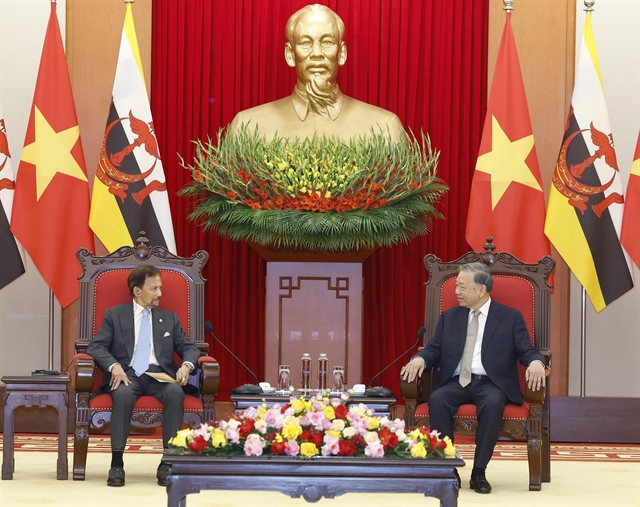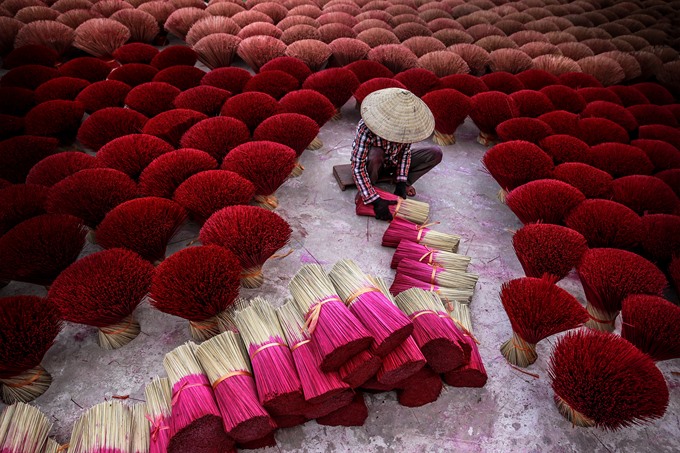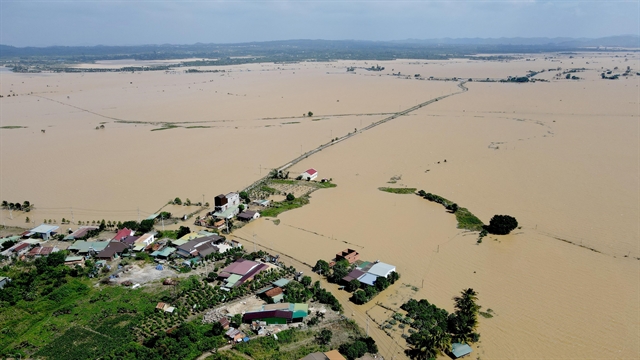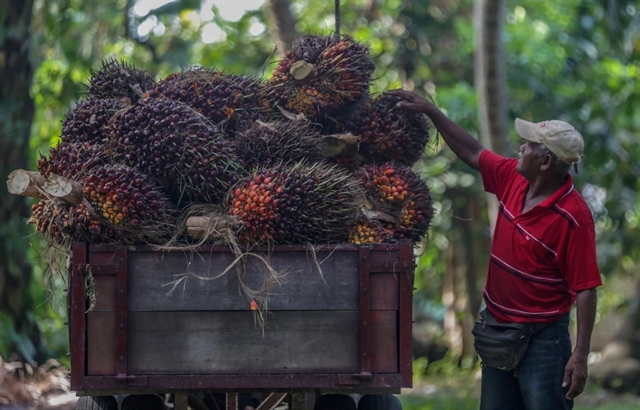

Trần Tuấn Việt is an up-and-coming photographer. No other photographer in the country has had as many photos recognised by the online photographic community of National Geographic magazine.
 |
| Making incense: A woman dries incense sticks at a craft village in Quảng Phù Cầu Commune in Hà Nội’s outer district of Ứng Hòa.Photo Trần Tuấn Việt |
Trần Tuấn Việt is an up-and-coming photographer.
No other photographer in the country has had as many photos recognised by the online photographic community of National Geographic magazine.
Trần Tuấn Việt started photography after studying architecture and working in IT.
He believes his pictures are a way of telling stories.
by Bảo Hoa
Trần Tuấn Việt doesn’t have that worn-out, dusty appearance of most photographers. Wearing glasses, with a clean-cut look and a confident half-smile, he gives off the impression of a lawyer who had studied his case well before trial.
Việt has been making headlines in Việt Nam as the photographer with the most photos getting recognised by international magazine National Geographic’s online photo community.
Over the past two years, 26 of his photos have been featured in the ‘Daily Dozen’ – a selection of 12 of the day’s best photos chosen by editors of the magazine’s online community Your Shot.
One of them, Making Incense, was printed in National Geographic’s Vision of Earth magazine in June 2017, and in its Specular photo book this month.
But Việt is not a photographer by default; he only picked up a camera after earning a degree in architecture and working for years in the IT industry. The thirty-something photographer spoke about visual storytelling and bringing images of Việt Nam to the world.
“I started out with photography in 2007 – it has been 11 years now. But it was not until 2015 that I found my own way of doing it,” he said at a photo workshop in August.
Visual storytelling “is not a genre of photography but a method to convey information,” Việt stressed.
“I pursue visual storytelling to convey stories and my subjective knowledge through photographs,” he told Việt Nam News in an email interview. “They could be portraits, landscapes, daily-life or conceptual photos… with stories behind them.”
Humans are the main subjects of Việt’s photos. His Daily Dozen photos focused on Vietnamese people during their daily routines.
Making Incense, his most widely-known work to date, depicts a woman in the process of drying incense at a craft village in Hà Nội. Lying around her are bunches of incense sticks turned upside down, looking vibrant with their red and pink colours.
Việt said it took him four months of emailing back and forth and answering tons of questions from National Geographic editors before the photo made it to Vision of Earth.
“I’m so pleased to have an image of Việt Nam featured in such a global magazine,” he said of the photo.
“I had a lot of friends telling me via Facebook that they saw copies of the magazine in Japan, the US, the UK, and asking me whether I wanted them to bring me a copy,” he added. “Those little comments made me happy.”
The achievement had a significant meaning for the photographer.
“It helped me understand more about the values of visual storytelling, about my capability, and the direction I want to go,” he said. “It did not create pressure for me but quite the contrary: it inspired me a lot.”
Việt’s efforts won praise from his colleagues, who rejoiced in his success.
A photographer with more than 20 years of experience, Nguyễn Long Hưng, said: “The fact that Việt has 26 photos featured on National Geographic is very meaningful. He has helped promote Vietnamese culture to the world, and such an achievement is very rare for photographers at his age.
“The topics Việt chose for his photos were nothing new and had been done countless times over the decades, but he’s got a fresh perspective,” he added.
“His achievement is a great encouragement for young photographers, because judges at international photo contests tend to be fairer and do not let personal relationships interfere with their job.”
Nam Nguyễn, 25, a photography student from the Martin Luther University of Halle-Wittenberg in Germany, is impressed by the photos’ high aesthetic values.
“They look nice. The composition is good, he has put a lot of thought into them,” he said. “He has utilised editing software well, too.”
Việt said he liked American photographer Steve McCurry and his journey of telling stories that reflect culture, tradition and human values.
And even though he has brought home many top prizes from domestic and international photo contests, Việt said winning awards is not the ultimate purpose of his practice.
“I would like to do more photography or storytelling projects that are meaningful, practical, and have human values,” he said.
“I want to tell more stories and more powerful stories about love and meaningful things in life – stories that are universal and strive towards values that people from anywhere, of any ethnicity or religion, can feel and understand.
“Those are the values I’m striving for and wanting my photos to convey, not stopping at bringing Việt Nam’s images, culture, tradition and beauty to the world through a particular lens.” — VNS
GLOSSARY
Wearing glasses, with a clean-cut look and a confident half-smile, he gives off the impression of a lawyer who had studied his case well before trial.
If someone is confident they believe in themselves.
To give an impression of lawyer who had studied his case well before trial means to look as if this is who you are.
A lawyer is a person who has studied law and stands up for people in court cases.
A trial is a procedure in a court case that is held to decide whether someone who is accused of breaking the law has done so, or not.
Over the past two years, 26 of his photos have been featured in the ‘Daily Dozen’ – a selection of 12 of the day’s best photos chosen by editors of the magazine’s online community Your Shot.
A selection of photos is a collection of photos that have especially been chosen.
But Việt is not a photographer by default; he only picked up a camera after earning a degree in architecture and working for years in the IT industry.
By default here means “in the absence of other choices”.
Architecture is the study of designing houses.
Visual storytelling “is not a genre of photography but a method to convey information,” Việt stressed.
A genre of photography is a style of photography.
A method of conveying information is a way of conveying information.
To convey information means to pass on information.
“I pursue visual storytelling to convey stories and my subjective knowledge through photographs,” he told Việt Nam News in an email interview.
To pursue something means to work at it with a specific goal in mind.
Visual storytelling means telling a story through things that people can see, such as photographs at an exhibition.
A subjective knowledge of something is a knowledge influenced by an opinion.
An interview is a meeting between people in which one asks questions of the other, or others.
“They could be portraits, landscapes, daily-life or conceptual photos… with stories behind them.”
Portraits are pictures of people posing in a formal way.
Conceptual photos are photos that are based on ideas rather than real things.
Humans are the main subjects of Việt’s photos. His Daily Dozen photos focused on Vietnamese people during their daily routines.
The subject of a photo is the topic or person that the photo is about.
Making Incense, his most widely-known work to date, depicts a woman in the process of drying incense at a craft village in Hà Nội. Lying around her are bunches of incense sticks turned upside down, looking vibrant with their red and pink colours.
Depicts means represents.
“I’m so pleased to have an image of Việt Nam featured in such a global magazine,” he said of the photo.
An image means a picture.
The achievement had a significant meaning for the photographer.
Significant means important.
“It helped me understand more about the values of visual storytelling, about my capability, and the direction I want to go,” he said. “It did not create pressure for me but quite the contrary: it inspired me a lot.”
Someone has the capability to do something if they are able to do it in a skilled and efficient way.
The contrary means the opposite.
If something inspires you, it fills you with energy to want to do something positive.
Việt’s efforts won praise from his colleagues, who rejoiced in his success.
Colleagues are people who you work with.
Rejoiced means to show great joy.
He has helped promote Vietnamese culture to the world, and such an achievement is very rare for photographers at his age.
To promote something means to say good things about it.
This achievement is rare for a person of his age because it is not often achieved by someone of that age.
“The topics Việt chose for his photos were nothing new and had been done countless times over the decades, but he’s got a fresh perspective,” he added.
Countless means very often.
A decade is a period of ten years.
A perspective is an attitude that involves a certain point of view.
“His achievement is a great encouragement for young photographers, because judges at international photo contests tend to be fairer and do not let personal relationships interfere with their job.”
To interfere means to get involved in something when it is none of your business.
Nam Nguyễn, 25, a photography student from the Martin Luther University of Halle-Wittenberg in Germany, is impressed by the photos’ high aesthetic values.
Aesthetic means nice to see.
“The composition is good, he has put a lot of thought into them,” he said.
The composition of a photograph is how it is made up with certain things positioned where they are.
“He has utilised editing software well, too.”
Utilised means used.
Việt said he liked American photographer Steve McCurry and his journey of telling stories that reflect culture, tradition and human values.
Reflect means show.
And even though he has brought home many top prizes from domestic and international photo contests, Việt said winning awards is not the ultimate purpose of his practice.
Domestic photo contests are contests held within Viet Nam.
Ultimate means final
“Those are the values I’m striving for and wanting my photos to convey, not stopping at bringing Việt Nam’s images, culture, tradition and beauty to the world through a particular lens.”
A lens is a curved piece of glass found in a camera.
WORKSHEET
Find words that mean the following:
© Duncan Guy/Learn the News/ Viet Nam News 2018
1. Germany; 2. Humans; 3. Judges; 4. Student; 5. Twelve.




